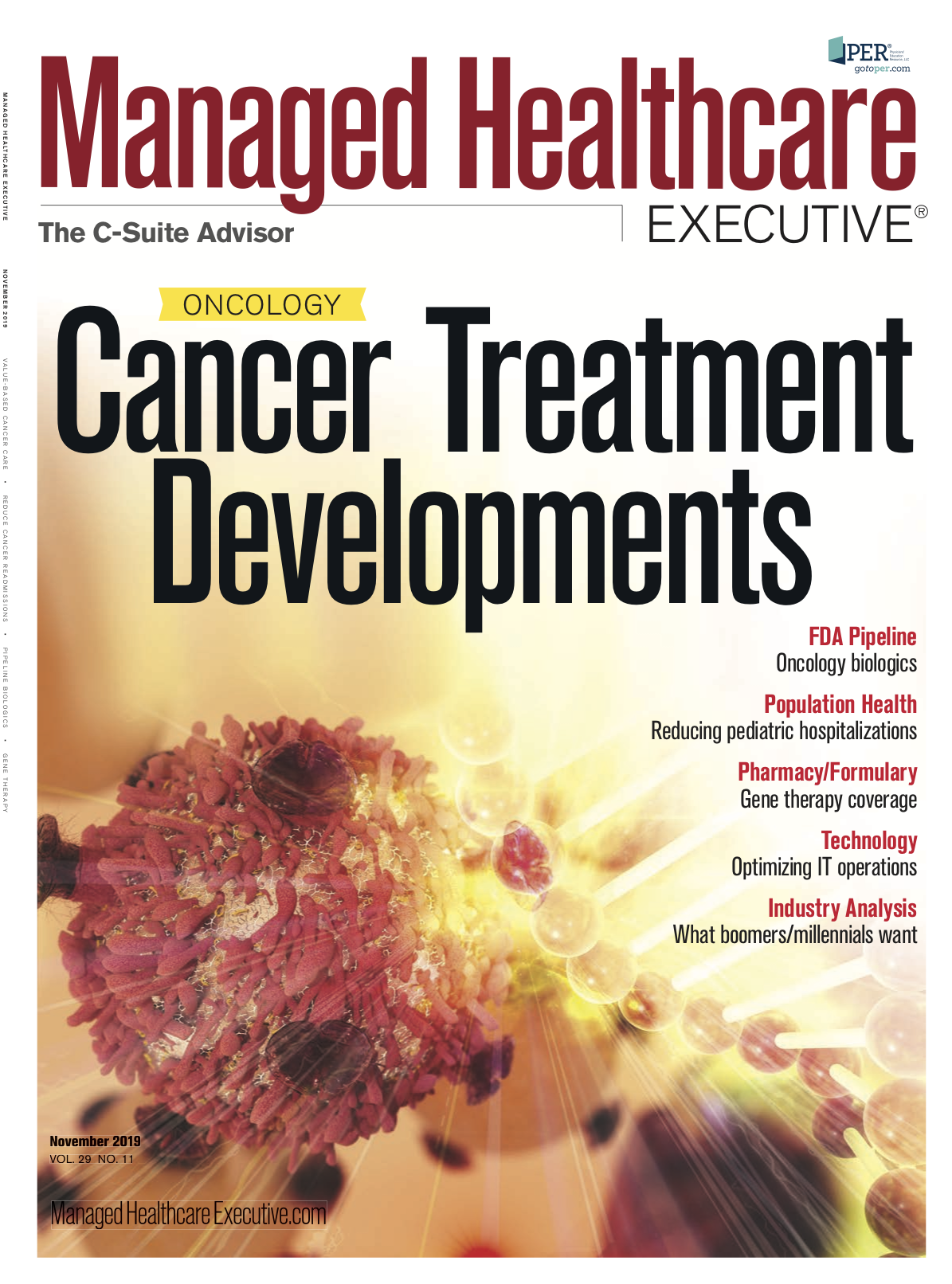Accessibility and Affordability of Gene Therapy
Payers are finding ways for members to afford expensive specialty drug treatments.

Steve Miller

Brian Duffant

The race to decrease drug costs is heating up across America. The Trump Administration has one idea, House Majority Leader Nancy Pelosi has her solution and Big Pharma has prosed a resolution to the problem. But some insurers are now rising to the occasion and finding ways for members to afford expensive specialty drug treatments, such as gene therapy.
The cost of gene therapies is expected to reach more than $16 billion in the United States by 2024. While only two therapies have yet to be approved, they are indicative of the high price tag.
Luxturna (voretigene neparvovec-rzyl), the first FDA-approved prescription gene therapy for people with inherited retinal disease leading to blindness, costs $415,000 per eye. Zolgensma (onasemnogene abeparvovec-xioi) for children under two years old with spinal muscular atrophy is set at $2.1 million.
These potentially life-saving medications would undoubtedly break the bank and prevent coverage and access by patients.
Embarc eliminates copayments
Cigna has developed a coverage program, Embarc Benefit Protection, for the two therapies that don’t require any out-of-pocket payments related to the cost of the medicine. It is expected to go live by January 2020.
Payers pay a per-member per-month (PMPM) fee to access Embarc’s gene therapy network. Physicians are required to submit prior authorization requests for patient eligibility. Steve Miller, MD, chief medical clinical officer for Cigna, hopes that PMPM will reach $1.
Miller says that Cigna chose gene therapy because of the integral part it will play in overall healthcare. He also is concerned by the history of gene therapies, two of which were approved in Europe and have since been taken off the market because they are cost prohibitive.
“Without patient access, a product can become a tremendous market failure,” Miller says. “Some plans are writing policies to exclude gene therapy, while stop-loss insurers are capping their exposure. Although gene therapy is not yet urgent or presenting any threat, we want to capture the market before insurers decide to exclude these treatments from their benefits.”
He wants to eliminate all barriers to joining the Embarc coalition of subsidiaries and affiliates so that patients are not forced into government insurance. The program initially will target Cigna members followed by Express Scripts’ book of business, then EviCor and finally non-affiliated health plans.
Brian Duffant, vice president at BluePath Solutions, a market access and health economics/outcomes research consulting firm based in Los Angeles, says payers are developing new payment programs to address the projected future increase in demand for gene therapies based on the burgeoning gene therapy pipeline.
The addressable market for gene therapies could grow as large as 2.4 billion patients worldwide, according to Guggenheim Securities.
Miller says Embarc will combine Cigna’s innovative payment with the health services, medical benefit management, and specialty pharmacy expertise of Express Scripts, a pharmacy benefits manager; eviCore, a healthcare management company; Accredo specialty pharmacy; and Curascript SD, a specialty pharmaceutical dispensing and distribution company.
AveXis, a subsidiary of Novartis Corp. that developed Zolgensma, also is partnering with Cigna’s coalition members offering payers pay-over-time options up to five years and outcomes-based agreements up to five years for the drug. In the same vein, the Cigna partnership will envelop Spark Therapeutics, the producer of Luxturna.
Related: Increasing Access to Gene Therapies Requires Innovative Payment Approaches
New kind of paradigm
“There wasn’t a paradigm in the private sector for this kind of coverage, but we wanted to get something out there,” Miller says.
Cigna chose an approach that considers the impact Embarc will have on all stakeholders, including manufacturers, providers, payers, and patients.
Embarc will create:
- Certainty of payment
- Uniform utilization management criteria
- Long-term follow-up of patients
- Value-based contracting
- Limits on barriers to access, eliminating the need for copayments
- Patient encouragement to make the best choice without financial support playing a role
Cigna anticipates providing best prices and value-based pricing, keeping the price of Zolgensma for example, within the range of traditional cost-effectiveness thresholds used by the Institute for Clinical and Economic Review (ICER)-not just what the market will bear, Miller says. ICER produces cost-effectiveness analyses.
For payers-employers, insurers, and unions-Embarc expects to provide low prices with pass-through and transparency; spread overhead among as many patients as possible; use uniform utilization management criteria so there is no adverse selection, which gives payers 100% predictability; and establish a flat PMPM not based on usage.
Cigna will enable payers to use Embarc as a white label, payment product to build Cigna’s coalition, Miller says.
Patients should receive speedy treatment without any copayments, while providers are expected to be part of centers of excellence to keep costs down.
Miller says patients will pay little-perhaps an administrative fee-to nothing for the new available gene therapies. By negotiating best prices with manufacturers, he anticipates it will be possible to buy down copayments.
“What is clear is that payers will likely use a combined approach to manage gene therapy utilization, including use of centers of excellence; population risk-pooling; and short- and long-term, outcomes- based contracts with manufacturers, reinsurance, and programs intended to pay for gene therapy over time as opposed to one up-front payment,” Duffant explains.
A report developed by the PwC Health Research Institute (HRI) outlines a menu of contracting and price-assistance models that could make gene therapy more accessible and affordable.
HRI, however, found in a survey that just 56% of pharmaceutical executives reported using at least one value-based drug contract, while only 14% of payers said they engaged in outcomes-based agreements with biopharmaceutical companies.
Cigna is working on version two of Embarc that will target patients most likely to benefit from gene therapy to limit adverse risk. “The product will begin to look more traditional as more patients are involved and prices decrease,” Miller says.
Coverage challenges lurk
Duffant is concerned that if a small employer has even one patient who needs gene therapy, this could have a catastrophic impact on employers’ overall healthcare spend. “Payers need a way to manage a new paradigm of gene therapies with a high one-time upfront cost and uncertain clinical benefits over the long-term,” he says.
“While some of the populations eligible for gene therapies may be relatively small compared to other therapeutic areas, gene therapies generally address clear areas of unmet medical need and have short-term data as proof of evidence in select patient populations,” Duffant says. “The key question is whether gene therapies can deliver the promise of long-term health benefits for patients, and we are simply too early in the game to see if this will be true.”
Steve Wojcik, vice president, public policy, National Business Group on Health, believes that programs like Embarc sound like an installment finance option versus a one-time expense to cover gene therapies. “They should provide more predictability for employers and can spread payment over a period of time,” he says.
He recommends using clinical management tools to target the right persons with the right therapies.
Although it is a new way of financing specialty pharmacy and gene therapy, it doesn't get to the challenge posed by these expensive drugs; it doesn't address long-term sustainability and is out of line with economic and wage growth,” Wojcik says. “It is similar to covering college expenses while not addressing inflation.”
He concedes that patients are shielded from cost sharing, but acknowledges an underlying payment exists. He is concerned that smaller employers are apt to face higher premiums to offset the pricing arrangement. “There are already limits on OOP payments,” Wojcik says.
While he doesn’t expect a big impact initially with these payment programs, he believes that as more gene therapies hit the marketplace and affect a wider population, the result could have more significance and provide affordable healthcare.
Other insurers to jump on coverage bandwagon
Ethan Slavin, spokesperson for Aetna, says the insurer is working hard to effectively manage the cost of these therapies for its clients and members. For example, Aetna is currently developing:
- Refined pharmacy benefit management strategies, including formulary and utilization management programs, for therapy classes with high-cost entrants that have available alternatives.
- Stop-loss products for clients looking to better control medical costs, including an innovative reinsurance instrument specifically designed for gene therapies.
- Alternative payment models, including annuity payments that spread the cost of ultra-high cost drugs over a period of time, and may provide some clients with options to control spending in a single year.
The heath plan also is exploring outcomes-based contracts with manufacturers to ensure patients and customers derive clinical benefit and value from gene therapy products. In addition, Aetna is advancing a network strategy that ensures patients receive treatment at high-value sites of care in terms of both clinical quality and cost.
According to an article published by the Advisory Board, Anthem has a product under consideration that includes reimbursement or stop-loss options that would protect employers from the negative financial repercussions of gene therapies.
Mari Edlin, a frequent contributor to Managed Healthcare Executive, is based in Sonoma, California.

This week on Tuning Into The C-Suite Briana Contreras spoke with Dr. Scott Hayworth, president and CEO of New York-based CareMount Medical. In this interview, the two discussed the importance of patients staying in contact with their doctors for the sake of reducing public health risks and to discuss ongoing care options with them.
Listen
Eric Levin talks PBMs and how Scripta is Tackling the Market's Challenges for Patients
July 22nd 2020MHE's Briana Contreras spoke with CEO of Scripta, Eric Levin. The two discussed the current state of the pharmacy benefit market and how the Scripta organization has been assisting its clients and their prescriptions prior to the COVID-19 pandemic and during.
Listen